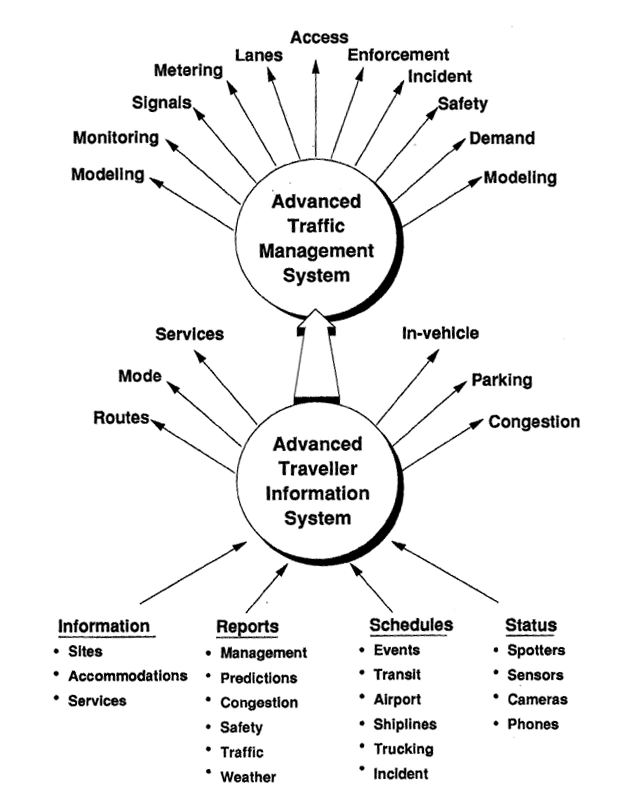| Name | Justin Helmer |
|---|---|
| Class | 480 |
| Year | 2012 |
| Quarter | Fall |
| Section | 1 |
| Presentation Date | September 20, 2012 |
| Presentation Given | Yes |
| Topic(s) | Intelligent Traffic Systems |
Abstract
We all agree it is frustrating to be sitting at a red light in the middle of the night when there is no one for miles, but how else can we apply today's technology to efficiently manage existing transportation resources in response to dynamic traffic conditions? This topic relates to artificial intelligence in the application of Advanced Traffic Management systems (ATM systems), something that would greatly improve safety and efficiency, and something I have personal invested interested in.
As we know them today, traffic management systems are quite limited. Various algorithmic solutions have been implemented throughout recent history, and if you pay careful attention, you will start to recognize these patterns relating to time, order, and other simple parameters. However, regardless of improvements to these algorithms over time, thier main focus remainds the same: to address the control of traffic lights at intersections. This method of traffic control management is very restrictive, especially considering the scope of techology we have at our fingertips.
There has yet to be any approaches that address the need for overall transportation management; this includes not only surface street intersections, but also highways, public transportation, and emergency response (just to name a few). These Advanced Traffic Management (ATM) systems should not be independent; rather, the network of information should all be aggregated and analyzed given a wide array of parameters that represent the current conditions of the road. Such conditions might include real-time information for relevant weather conditions, transit and airport schedules (even event schedules such as football games), incident reports, traffic congestion reports, etc. This will allow the central processor of the ATM to build accurate predictions and make safe, efficient traffic management decisions at freeway onramps, intersections, and more.
These ATM systems should not only respond dynamically given new inputs, but must minimally incorporate all various modes of transportation. For example, emergency response vehicles and semi-trucks have special needs such as priority or path restrictions, and this information needs to be incorporated into the analysis of such systems. This type of information insinuates that there would be additional hardware built in to each vehicle. Expanding on this concept, one might consider a number of various improvements that could be made to the in-dash navigation, provided a full integration with the ATM system. Based on said predictions and traffic control decisions, travellers can be updated in real-time with information on the best routes to take or most efficient transportation modes available, the availability of certain services, the avoidance of certain congestion situations or traffic incidents, heads-up of emergency response vehicles needing access to the road, parking availability and much more.
Figure 1 below shows an illustrative diagram of how the ATM and the traveller's navigation system could in theory all work together to provide accurate live information and manage traffic control decisions:

Figure 1: Advanced Traffic Management System and integration with an advanced navigation for travellers
Gerogia Tech is currently working on an artifical intelligence approach to solving many of the traffic control issues we face today, and has seen positive results in their simulations. Although a project of this magnitude would be incredibly complicated to implement on anything other than a very small scale, the technology is not far off, which gives promise to better traffic management solutions in the not-so-distant future.
References
Several very interesting articles from DENSO Global:
http://www.globaldenso.com/en/technology/product/electronics/index.html
Interview with Dr. Simon Box (Transportation Research Group):
http://www.youtube.com/watch?v=j8nntynXGIA
Press Release from the University of Southampton:
http://www.engadget.com/2012/08/26/scientists-investigating-ai-based-traffic-control/
And, of course, Wikipedia:
http://en.wikipedia.org/wiki/Intelligent_transportation_system
To view the main source of diagrams used for the presentation, you must have access to the 480-F12 section of PolyLearn, and visit the following link:
https://polylearn.calpoly.edu/AY_2012-2013/mod/forum/discuss.php?d=4035#p8153
I apologize for any inconvenience this may cause for future students; there is no way to upload a PDF document to this WIKI page.